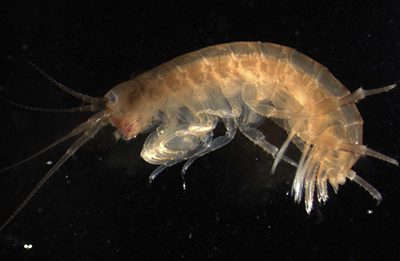
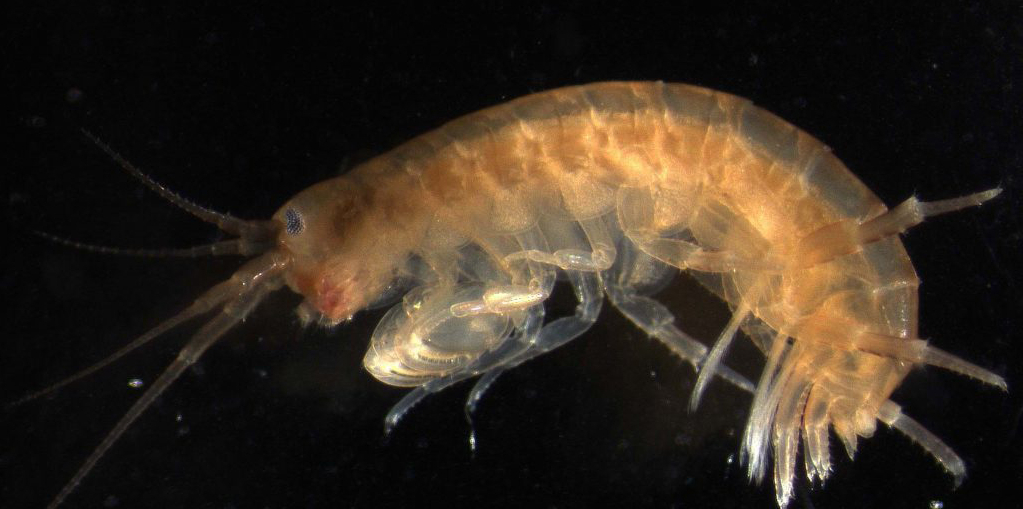
Search for the "wings" of a crustacean sheds light on origins of insect wings
By Susan Meikle, university news and communications
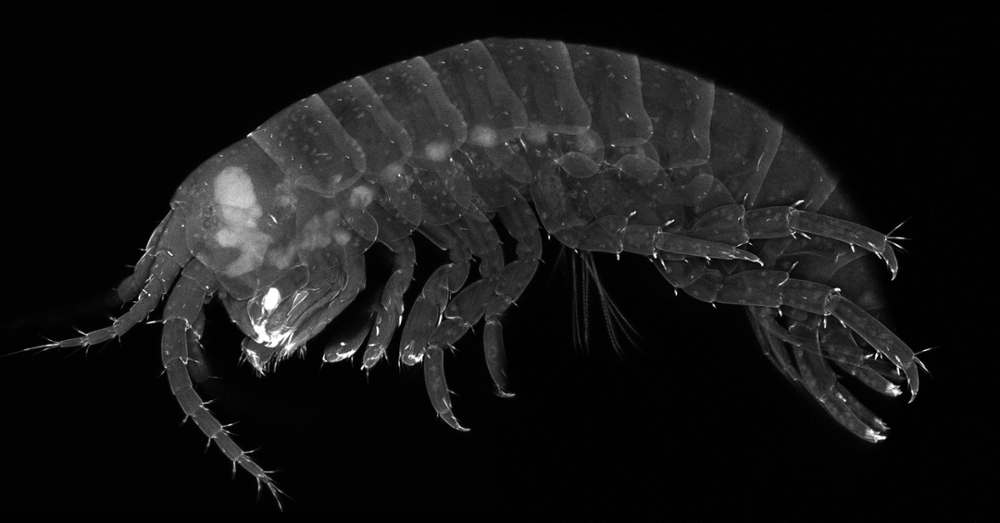
A Parhyale hatchling (image by Courtney Clark-Hatchel).
Genes from a tiny shrimp-like crustacean could help in the search for the origin of insect wings, a new study finds.
To be clear, there is no evidence that any crustaceans ever evolved to fly, according to evolutionary biologist Yoshi Tomoyasu, associate professor of biology at Miami University and senior author of the study recently published in Nature Ecology and Evolution.
The origin of insect wings is a biological mystery that has fascinated scientists for centuries. Insects evolved their wings long before birds and bats, yet, we do not know how their wings evolved, said Courtney Clark-Hatchel (Miami ’12, Ph.D. ’18), first author of the paper.
"Through searching for the 'wings' of a crustacean we hope to gain an understanding of where insect wings came from and how this novel structure emerged," she said.
In their study, Clark-Hatchel and Tomoyasu investigated the function of genes in the crustacean Parhyale whose insect counterparts are important for making wings. Their earlier research in insects identified two distinct types of tissues that contribute to form a complete wing.
In Parhyale, which has a body plan similar to that of insects (but without wings), they found that a gene network similar to the insect wing gene network acts on two separate tissues — the terga (back of the body) and the proximal leg (or upper part of the leg), similar to those analogous tissues in insects.
"It is striking to compare the potential wing homologs of Parhyale with those that have been identified in the wingless segments of insects," Clark-Hatchel said.
Their results appear to support a dual evolutionary origin of insect wings. Previously reported studies by Tomoyasu and David Linz (Miami '10, Ph.D. '17) show that a novel structure (the wing) can evolve through the collaboration of two previously unassociated tissues.
"These outcomes have a crucial impact on the course of the intellectual battle between the two historically competing wing origin hypotheses," Clark-Hatchel said.
Clark-Hatchel, currently a postdoctoral researcher at the University of North Carolina at Chapel Hill, developed the idea for this study while she was an undergraduate student working with Tomoyasu.
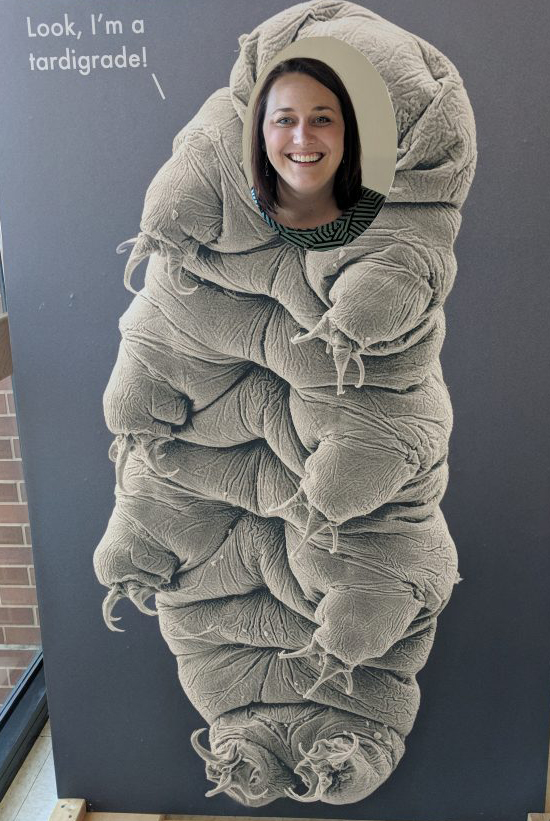 "This project, which was supposed to consist of looking at expression and function of one gene in Parhyale and take just a few months, ended up expanding to look at expression and function of three genes and expression alone of a handful more, and ended up taking about four years," she said.
"This project, which was supposed to consist of looking at expression and function of one gene in Parhyale and take just a few months, ended up expanding to look at expression and function of three genes and expression alone of a handful more, and ended up taking about four years," she said.
"Ultimately, the effort that went into this project was well worth it."
Read her blog post about the experience in Behind the Paper: The hunt for crustacean wings.
Follow them on Twitter:
- Yoshi Tomoyasu @yoshitomoyasu.
- Courtney Clark-Hatchel @ArthropodQueen. (Pictured at right posing as a tardigrade, one of the arthropods she currently studies).
Question-and-answer evolutionary biology tutorial with Tomoyasu
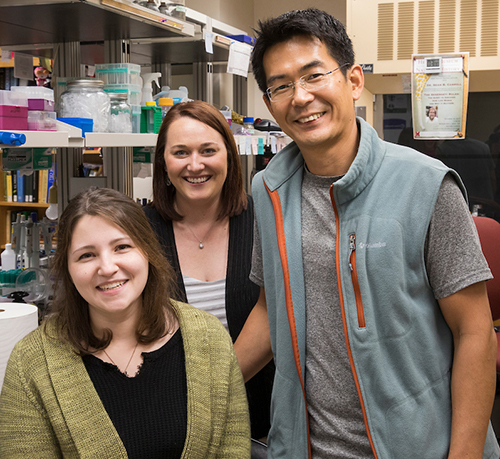
Left to right: Maddy Moe (Miami '18, current master's student), Courtney Clark-Hatchel and Tomoyasu, shown in his lab in 2018 (photo by Jeff Sabo).
What is a wing homolog?
Wing homologs are the tissues that have common ancestry with insect wings but not necessarily used for flight.
What is an arthropod?
Insects and Parhyale are arthropods. An arthropod is an invertebrate animal having an exoskeleton, a segmented body and paired jointed appendages: insects, arachnids (i.e. spiders, mites), myriapods (i.e. centipedes), and crustaceans (i.e. shrimp, crabs).
- With more than 1 million species that live on land, in the sea and air, arthropods make up 75% of Earth's living and fossil organisms.
Did insects evolve from crustaceans?
Yes, it is thought so. Among arthropods, insects are most closely related to crustaceans, and thus may have evolved from a group of crustaceans.
What are the oldest-known insects with wings?
I believe that the oldest-known winged insects were those that belonged to the extinct order Palaeodictyoptera, which are most closely related to insects such as mayflies and dragonflies.
Is there any evidence that any crustaceans ever evolved to fly?
No.
Undergraduate Research: Making it work within the coronavirus pandemic restrictions
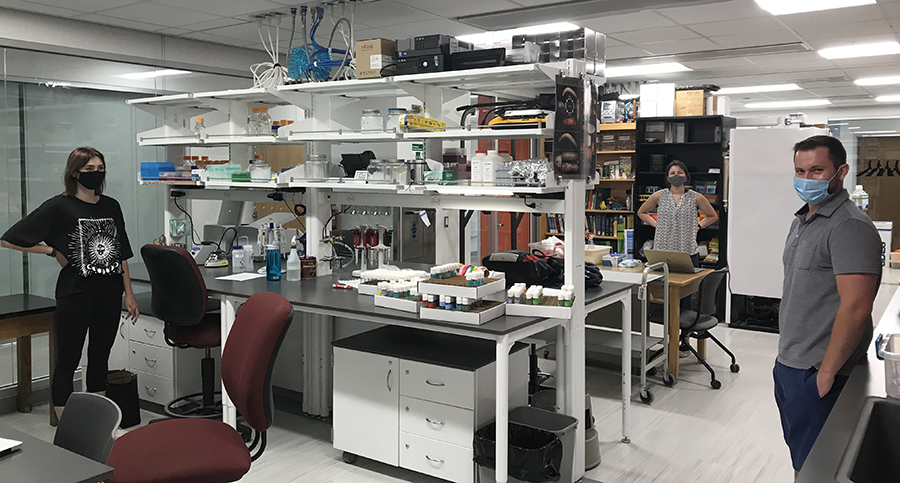
Tomoyasu's current graduate students move in to his recently-renovated lab in Pearson Hall. Left to right: Ellen Tieke , Maddy Moe and Kevin Deem (photo by Tomoyasu).
Clark-Hatchel is among several Tomoyasu graduate students who also worked in his lab as undergraduates.
How can undergraduate research work this fall, with social-distancing guidelines?
With an average of 2,000-2,800 Miami undergraduates participating in research each year, social distancing cannot be maintained in most situations, said Michael Crowder, associate provost and dean of the graduate school and interim vice president of research and innovation.
For the Fall 2020 semester, each faculty member or director will evaluate if undergraduate research/work can be safely conducted in their lab, research facility or studio.
- In Tomoyasu’s lab — as in most other research labs in the biology department — two undergraduate students are conducting research in person this semester. They join his three graduate students, doctoral candidate Kevin Deem (Miami ’14) and master’s students Maddy Moe (Miami ’18) and Ellen Tieke).
- His three other undergraduate student researchers, plus one high school student, attend lab meetings remotely, to keep up to date on the current research projects.
The office of research and innovation guidelines state that undergraduate students are given priority in the labs/studios if they:
- Have externally-funded research fellowships.
- Are working on externally-funded research projects.
- Need to complete critical lab/studio requirements for graduation.
- Have required honors/research capstone projects.
